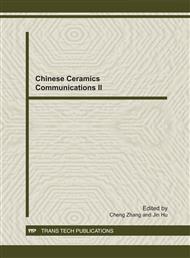[1]
P. Curie: J. de Physique Vol. 3 (1894), P. 393.
Google Scholar
[2]
J. F. Scott: Nat. Mater. Vol. 6 (2007), P. 256.
Google Scholar
[3]
E. Fischer, G. Gorodetsky and R. M. Hornreich: Solid State Commun. Vol. 10 (1972), P. 1127.
Google Scholar
[4]
N. A. Hill: J. Phys. Chem. B Vol. 104 (2000), P. 6694.
Google Scholar
[5]
X. D. Qi, M. Wei, Y. Lin, et al.: Appl. Phys. Lett. Vol. 86 (2005), P. 071913.
Google Scholar
[6]
H. Schmid: Ferroelectrics Vol. 221 (1999), P. 9.
Google Scholar
[7]
G. L. Song, T. X. Wang, C. J. Xia, et al.: Adv. Mater. Vol. 150-151 (2011), P. 1470.
Google Scholar
[8]
Y. Wang and C. W. Nan: Thin Solid Films Vol. 517 (2009), P. 4484.
Google Scholar
[9]
N. A. Hill and A. Filippetti: J. Magn. Magn. Mater. Vol. 242-245 (2002), P. 976.
Google Scholar
[10]
C. Michel, J. M. Moreau, G. D. Achenbach, et al.: Solid State Commun. Vol. 7 (1969), P. 701.
Google Scholar
[11]
G. D. Achenbach, W. J. James and R. Gerson: J. Am. Ceram. Soc. Vol. 8 (1967), P. 437.
Google Scholar
[12]
M. M. Kumar, V. R. Palkar, K. Srinivas, et al.: Appl. Phys. Lett. Vol. 76 (2000), P. 2764.
Google Scholar
[13]
V. F. Freitas, H. L. C. Grande, S. N. de Medeiros, et al.: J. Alloys. Compd. Vol. 461 (2008), P. 48.
Google Scholar
[14]
D. C. Jia, J. H. Xu, H. Ke, et al.: J. Euro. Ceram. Soc. Vol. 29 (2009), P. 3099.
Google Scholar
[15]
T. J. Park, G. C. Papaefthymiou, A. J. Viescas, et al.: Nano. Lett. Vol. 7 (2007), P. 766.
Google Scholar
[16]
J. M. Xu, G. M. Wang, H. X. Wang, et al.: Mater. Lett. Vol. 63 (2009), P. 855.
Google Scholar
[17]
F. G. Garcia, C. S. Riccardi and A. Z. Simoes: J. Alloys. Compd. Vol. 501 (2010), P. 25.
Google Scholar
[18]
Q. H. Jiang, C. W. Nan and Z. J. Shen: J. Am. Ceram. Soc. Vol. 89 (2006), P2123.
Google Scholar
[19]
X. B. He and L. Gao: Ceram. Int. Vol. 35 (2009), P. 975.
Google Scholar
[20]
Y. Q. Zheng, G. Q. Tan, H. Y. Miao, et al.: Mater. Lett. Vol. 65 (2011), P. 1137.
Google Scholar
[21]
S. H. Han, K. S. Kim, H. G. Kim, et al.: Ceram. Int. Vol. 36 (2010), P. 1365.
Google Scholar
[22]
H. Ke, W. Wang, Y. B. Wang, et al.: J. Alloys. Compd. Vol. 509 (2011), P. 2192.
Google Scholar
[23]
J. T. Wu. S. Y. Mao, Z. G. Ye, et al.: J. Mater. Chem. Vol. 20 (2010), P. 6512.
Google Scholar
[24]
Y.P. Wang, L. Zhou, M. F. Zhang, et al.: Appl. Phys. Lett. Vol. 84 (2004), P. 1731.
Google Scholar
[25]
Z. X. Yue, J. Zhou, L. T. Li, et al.: J. Magn. Magn. Mater. Vol. 308 (2000), P. 55.
Google Scholar


